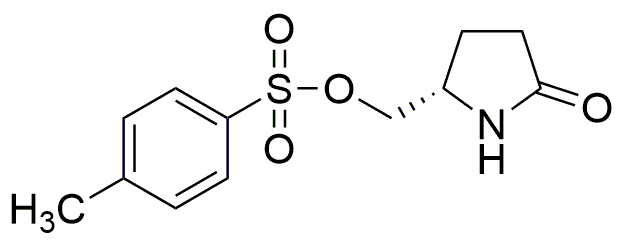(S)-(+)-5-(Hydroxymethyl)-2-pyrrolidinone p-toluenesulfonate is widely utilized in research focused on:
- Pharmaceutical Development: This compound serves as an intermediate in the synthesis of various pharmaceuticals, particularly in the production of drugs that target central nervous system disorders.
- Biochemical Research: It is used in biochemical assays to study enzyme activity and protein interactions, providing insights into metabolic pathways and disease mechanisms.
- Cosmetic Formulations: The compound is incorporated into skincare products for its moisturizing properties, enhancing skin hydration and texture.
- Polymer Chemistry: It acts as a building block in the synthesis of specialty polymers, which are used in coatings and adhesives, offering improved durability and performance.
- Food Industry: This chemical is explored as a food additive for its potential to enhance flavor profiles and improve the stability of food products.
General Information
Properties
Safety and Regulations
Applications
(S)-(+)-5-(Hydroxymethyl)-2-pyrrolidinone p-toluenesulfonate is widely utilized in research focused on:
- Pharmaceutical Development: This compound serves as an intermediate in the synthesis of various pharmaceuticals, particularly in the production of drugs that target central nervous system disorders.
- Biochemical Research: It is used in biochemical assays to study enzyme activity and protein interactions, providing insights into metabolic pathways and disease mechanisms.
- Cosmetic Formulations: The compound is incorporated into skincare products for its moisturizing properties, enhancing skin hydration and texture.
- Polymer Chemistry: It acts as a building block in the synthesis of specialty polymers, which are used in coatings and adhesives, offering improved durability and performance.
- Food Industry: This chemical is explored as a food additive for its potential to enhance flavor profiles and improve the stability of food products.
Documents
Safety Data Sheets (SDS)
The SDS provides comprehensive safety information on handling, storage, and disposal of the product.
Product Specification (PS)
The PS provides a comprehensive breakdown of the product’s properties, including chemical composition, physical state, purity, and storage requirements. It also details acceptable quality ranges and the product's intended applications.
Certificates of Analysis (COA)
Search for Certificates of Analysis (COA) by entering the products Lot Number. Lot and Batch Numbers can be found on a product’s label following the words ‘Lot’ or ‘Batch’.
*Catalog Number
*Lot Number
Certificates Of Origin (COO)
This COO confirms the country where the product was manufactured, and also details the materials and components used in it and whether it is derived from natural, synthetic, or other specific sources. This certificate may be required for customs, trade, and regulatory compliance.
*Catalog Number
*Lot Number
Safety Data Sheets (SDS)
The SDS provides comprehensive safety information on handling, storage, and disposal of the product.
DownloadProduct Specification (PS)
The PS provides a comprehensive breakdown of the product’s properties, including chemical composition, physical state, purity, and storage requirements. It also details acceptable quality ranges and the product's intended applications.
DownloadCertificates of Analysis (COA)
Search for Certificates of Analysis (COA) by entering the products Lot Number. Lot and Batch Numbers can be found on a product’s label following the words ‘Lot’ or ‘Batch’.
*Catalog Number
*Lot Number
Certificates Of Origin (COO)
This COO confirms the country where the product was manufactured, and also details the materials and components used in it and whether it is derived from natural, synthetic, or other specific sources. This certificate may be required for customs, trade, and regulatory compliance.

